












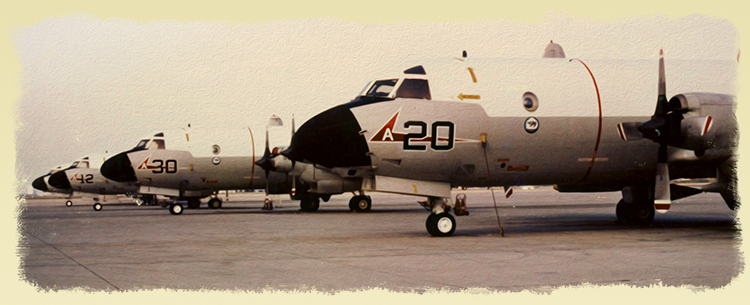
1963-1972:
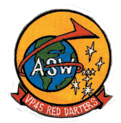 In September 1963 the Pelicans established detachments at Patuxent River and Jacksonville to commence transition to the new Lockheed P-3A Orion. Homeport was changed to NAS Jacksonville on 1 January 1964 under CDR J. D. Collins, who had relieved CDR Chappell in December 1963.
In September 1963 the Pelicans established detachments at Patuxent River and Jacksonville to commence transition to the new Lockheed P-3A Orion. Homeport was changed to NAS Jacksonville on 1 January 1964 under CDR J. D. Collins, who had relieved CDR Chappell in December 1963.
The squadron became operational in the P-3 in May 1964 and began a 5 plane detachment to Argentia, Newfoundland until February 1965, while at the same time maintaining detachments to Panama, Azores, Bermuda and NAS Brunswick. Crew 10 aboard LN-9 was lost in Argentia near the end of 1964. The cause was attributable to faulty generators in icing conditions. The squadron won the COMNAVAIRLANT ‘E’ Award, the CNO Safety Award for all VP squadrons, and other awards for superior performance in aircraft maintenance and retention. CDR D. M. Hume relieved CDR Collins in December 1964 and kept the reins until relieved by CDR J. H. Chapman in December 1965. In July of 1965, VP-45 became the first Atlantic VP squadron to augment the Pacific Fleet in support of Southeast Asia operations when it deployed to Adak, Alaska under operational control of COMALSEAFRON (Commander Alaskan Sea Frontier - which was disestablished in 1971), and returned to JAX in January 1966. During the next six month deployment, to Bermuda with six planes, CDR J. W. Townes, Jr. relieved CDR Chapman in November 1966, and the squadron received a Letter of Commendation from CINCLANT and COMASWFORLANT for carrying out ASW operations in the central Atlantic and became the first squadron to have a P-3 visit Sigonella, Sicily and Northolz, West Germany.
From January to June 1967 the squadron was "at home". Another "first" occurred when VP-45 sent a plane and crew to attend the Joint ASW School in Londonderry, Northern Ireland, and operated detachments in Panama and Ascension Island in the South Atlantic in May. In June 1967 a three plane detachment was sent to Argentia, completing the assignment in December 1967. CDR R. D. Wilbur relieved CDR Towns in November 1967.
In May 1968 VP-45 responded on two hours notice to the tragic loss of USS Scorpion by flying search and rescue missions from Bermuda and Lajes, Azores. NARMID ‘68 was next, and then the squadron began preparations for its next deployment to Southeast Asia in December 1968. CDR W. H. Saunders III, relieved CDR Wilbur in October 1968, prior to the deployment.
As scheduled, VP-45 departed JAX in December 1968 for a six-month deployment in support of combat operations in Vietnam, flying from NS Sangley Point, Philippines and U-Tapao, Thailand. For the accomplishments in Market Time, all crews were awarded at least two Air Medals in addition to the Vietnamese Service Medal and Vietnamese Campaign Medal. The squadron returned to JAX in June 1969. During the return to Jacksonville, the squadron lost an aircraft following an aborted take-off from Adak. The aircraft suffered strike damage due to fire but all crew members escaped without injury. CDR Saunders was relieved in August 1969 by CDR Ralph Mason, who led the squadron on its deployment in October 1969 to Rota, Spain with four planes and six crews, and returned to JAX in July 1970. CDR Stephen McArdle became the CO in August 1970.
In October 1970 the squadron deployed to Sigonella, Sicily for a four-month deployment, logging over 3500 flight hours, and earning the Meritorious Unit Commendation for its participation during the Jordanian situation. CDR C. F. Cook relieved CDR McArdle in June of 1971 and the following November the squadron conducted a six month split deployment between Rota and Lajes, and operated detachments from Souda Bay, Crete; Sal, Cape Verde Islands; and Sigonella, Sicily.
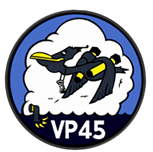 In April 1972 VP-45 gave up its P-3A's and began transitioning to the brand new P-3C, completing that evolution in October. CDR Paul Herring relieved CDR Charlie Cook in June, 1972 and in December 1972 a detachment was established at Lajes, Azores for two months. CDR Joe Notargiacomo relieved CDR Herring in June, 1973, and shortly thereafter the Pelicans commenced a six month deployment to Sigonella, Sicily; this was the very first forward deployment of the revolutionary P-3C to the Mediterranean area of operations. During the timeframe surrounding the Yom Kippur War in October of that year, the squadron conducted nearly 42 days of continuous round-the-clock flight operations from both Souda Bay, Crete and Sigonella...setting an unprecedented record of 1800 flight hours in a 30 day period! This record has never been matched! VP-45 was later awarded the Arnold J. Isbell Trophy for excellence in ASW for the period. The 1973 calendar year is arguably the finest period of time for this remarkable squadron. Were there a competition for such, VP-45, hands down, would have been the United States Navy's Premier Squadron.
In April 1972 VP-45 gave up its P-3A's and began transitioning to the brand new P-3C, completing that evolution in October. CDR Paul Herring relieved CDR Charlie Cook in June, 1972 and in December 1972 a detachment was established at Lajes, Azores for two months. CDR Joe Notargiacomo relieved CDR Herring in June, 1973, and shortly thereafter the Pelicans commenced a six month deployment to Sigonella, Sicily; this was the very first forward deployment of the revolutionary P-3C to the Mediterranean area of operations. During the timeframe surrounding the Yom Kippur War in October of that year, the squadron conducted nearly 42 days of continuous round-the-clock flight operations from both Souda Bay, Crete and Sigonella...setting an unprecedented record of 1800 flight hours in a 30 day period! This record has never been matched! VP-45 was later awarded the Arnold J. Isbell Trophy for excellence in ASW for the period. The 1973 calendar year is arguably the finest period of time for this remarkable squadron. Were there a competition for such, VP-45, hands down, would have been the United States Navy's Premier Squadron.
CDR Pat Ryan became Commanding Officer in June of 1974 and in July the squadron deployed to Keflavik, Iceland for a six-month period, returning just in time for Christmas. In June of 1975 CDR Bill Pendley relieved CDR Ryan and in August VP-45 deployed to Sigonella, and participated in several NATO and SIXTH Fleet exercises. The squadron was awarded the first SIXTH Fleet HOOK ‘EM Award for ASW 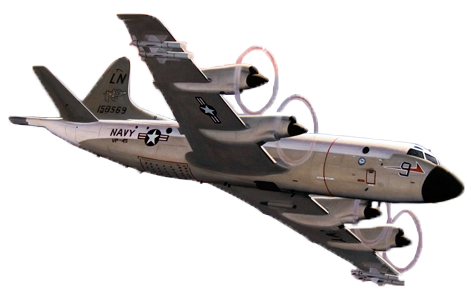 excellence in the Med, and logged nearly 6000 flight hours during the five month deployment.
excellence in the Med, and logged nearly 6000 flight hours during the five month deployment.
In June, 1976, CDR Steve Loftus relieved CDR Pendley, and beginning in July the squadron participated in UNITAS XVIII, an annual US South American naval exercise which required the Pelicans to operate detachments from Puerto Rico, Brazil, Uruguay, Argentina, Chile, Peru, Colombia, and Venezuela. In December 1976, a month after termination of UNITAS, VP-45 was on the move to a deployment to Keflavik, Iceland, returning to JAX in May 1977. CDR Charlie McKinney, Jr. relieved CDR Loftus in June 1977 and the squadron began preparations for deployment to Sigonella, Sicily early in 1978 (February - July). While deployed, squadron detachments operated from Souda Bay, Crete; Rota Spain; RAF Gibraltar; and Nimes-Garona, France while participating in various NATO and SIXTH Fleet exercises. CDR Bill Rodriguez relieved CDR McKinney in June 1978.
In May of 1979 the Pelicans returned to Sigonella for another five months, during which they earned another SIXTH Fleet HOOK ‘EM Award for the month of September. CDR R. F. Stephenson relieved CDR Rodriguez in June of 1979 while deployed to Sigonella.
CDR L. W. Carl became Skipper in June of 1980 and September 1980 saw the beginning of what would become a highly successful deployment to Bermuda. During the first two months of the deployment, VP-45 had detachments literally all over the world; in Bermuda; Jacksonville; Roosevelt Roads; Puerto Rico; Recife, Brazil; Diego Garcia; Kadena, Okinawa; Bankok, Thailand; and Cubi Point, Philippines. Reunited in Bermuda in December, the squadron conducted routine ASW operations, and one SAR operation for the Israeli freighter MEEZDA, before returning to JAX in March 1981. The performance of the Maintenance Department resulted in the awarding of the GOLDEN WRENCH Award, and the aircrews were awarded the TOP GUNNER Award for accurately putting torpedoes on target. The squadron also earned the SILVER ANCHOR Award for its retention program for 1980. CDR D. C. Bennett relieved CDR Carl in June of 1981.
Another deployment to Sigonella began in December 1981, to last for five and-a-half months. Patrol Squadron Forty-Five aircrews detached to Rota, Spain on several occasions to augment other VP squadrons from NAS Brunswick. Detachments were also made to RAF Gibraltar; Nimes-Garona, France; and Souda Bay, Crete, where the Pelican crews operated jointly with the RAF, US SIXTH Fleet and NATO forces. The squadron earned its second consecutive TOP GUNNER Award for accurate torpedo placement. CDR Bennett was relieved by CDR R. H. Phelan in July 1982.
CDR J. F. Phelan relieved CDR R. H. Phelan in July 1983, and October brought the Pelicans home from Sigonella after a record-setting deployment. VP-45 flight crews logged more submerged submarine contact hours during the deployment than any other squadron had done before. As a result of this outstanding performance, the squadron was awarded their third SIXTH Fleet "Hook ‘Em" award.
CDR S. L. Stoutamire became Commanding Officer in August of 1984 and in September VP-45 sent five aircraft to Rota, Spain and four to Lajes, Azores on a split deployment. In the five months that followed, VP-45 was awarded their fourth "Hook ‘Em" award and the coveted COMNAVAIRLANT Battle Efficiency ‘E’. In January 1986 CDR T. P. Lawler relieved CDR Stoutamire and the squadron deployed to Bermuda that summer.
The next Commanding Officer was CDR R. L. Hume, who relieved CDR Lawler in January of 1987. the following July, the squadron deployed again to Sigonella, flying over 4500 hours of high tempo operations in direct support of the SIXTH Fleet. Detachments were made to Rota; Nimes-Garon, France; and Dalaman, Turkey. VP-45 also participated in many SIXTH Fleet and NATO exercises, including National Week. The Pelicans returned home to NAS JAX, where they became the first active-duty patrol squadron to retrofit the P-3C baseline aircraft with the advanced Update III package.
The Pelicans had their work cut out for them during the 13 month at-home cycle (January 1988-February 1989) in order to complete a successful transition to the P-3C Update III. CDR C. J. Dale relieved CDR Hume in February 1988. The squadron received the Top Gunner award for excellence in the areas of armament and ordnance, and the U. S. Coast Guard Special Operations Services Ribbon for successful participation in the drug interdiction program. VP-45 was the first squadron participating in the Adopt a School program, a part of the CNO Personal Excellence program, in Clay County, Florida, by adopting Green Cove Springs Elementary School. The relationships fostered between the students and squadron personnel were extremely rewarding, resulting in a standard that all other Adopt a School program participants strove to achieve. VP-45 was recognized by President Bush as one if his Points of Light for their partnership in education with Green Cove Springs Elementary.
In February 1989, VP-45 deployed the updated P-3C to NAS Bermuda, the aircraft’s first operational deployment in the Atlantic. CDR W. B. Evers relieved CDR Dale in April 1989 while on deployment. Operating from detachment sites from Keflavik to Roosevelt Roads, the Pelicans achieved unparalleled success with the updated aircraft, and were awarded the Meritorious Unit Commendation by the Secretary of the Navy for their superb achievements. The squadron returned to NAS JAX in August 1989, and was nominated for the Arnold J. Isbell trophy for ASW excellence by COMPATWING ELEVEN.
 CDR J. R Cannon relieved CDR Evers in April of 1990, and the squadron againassumed the split deployment to Rota/Lajes in June of 1990, introducing the Update III platform to the Mediterranean. This highly successful deployment included direct support for Operation Sharp Edge in Liberia and Desert Shield in EASTMED, and earned a fifth SIXTH Fleet Hook ‘EM Award. Returning to NAS Jacksonville in January 1991, the Pelicans were again nominated for the Arnold J. Isbell Trophy and the squadron was selected by Commander, Naval Air Forces Atlantic as winners of the CNO Safety Award for 1991.
CDR J. R Cannon relieved CDR Evers in April of 1990, and the squadron againassumed the split deployment to Rota/Lajes in June of 1990, introducing the Update III platform to the Mediterranean. This highly successful deployment included direct support for Operation Sharp Edge in Liberia and Desert Shield in EASTMED, and earned a fifth SIXTH Fleet Hook ‘EM Award. Returning to NAS Jacksonville in January 1991, the Pelicans were again nominated for the Arnold J. Isbell Trophy and the squadron was selected by Commander, Naval Air Forces Atlantic as winners of the CNO Safety Award for 1991.
CDR A. A. Efriamson became Commanding Officer in April 1991 and the squadron sent a large detachment to Roosevelt Roads, Puerto Rico, for counter-narcotics operations in support of Commander Joint Task Force FOUR. Two months later the squadron conducted the first operational test and evaluation of the FORE/CAST advanced electro-optical and video transmission system. During 1991, VP-45 also became the test bed for the new Patrol Wing ELEVEN Tactical Proficiency Course (TPC) designed to improve aircrew training, coordination and readiness. In November, the Pelicans were tasked with exploiting the Global Positioning System (GPS), providing for the tactical application of satellite navigation in the Mine Warfare environment.
VP-45 also became the test bed for the new Patrol Wing ELEVEN Tactical Proficiency Course (TPC) designed to improve aircrew training, coordination and readiness. In November, the Pelicans were tasked with exploiting the Global Positioning System (GPS), providing for the tactical application of satellite navigation in the Mine Warfare environment.
In February 1992, the squadron embarked on an completely new concept in deployed site operations. Split between Keflavik, Iceland and Jacksonville, Florida, with frequent detachments to Lajes, Azores, objectives included aggressive participation in carrier battle group operations as well as continued interaction with other NATO countries in the area of shallow water ASW. CDR R. B. Brannon relieved CDR Efriamson in April 1992. On October 22 through 25, 1992, the squadron and the Patron Four Five Association of over 500 past squadron members celebrated the squadron’s Fiftieth birthday with a picnic at NAS JAX hosted by the squadron, a reception and banquet sponsored by the Association, and a brunch and squadron tour on Sunday, 25 October. CDR Brannon and Command Master Chief Hager spoke at the banquet, with CDR Brannon telling of the squadron’s accomplishments and honored all past members for their guidance and establishment of the great reputation still being carried on, and Chief Hager telling of the issues that most concern the enlisted personnel-Drawdown, Women in the Navy, and Quality of Life. Hagar noted the squadron had been awarded the Bronze Anchor for high retention, and that of the 260 member enlisted membership, 84 are women. He also noted that morale is in great shape and the squadron is, "...The Tip of the Spear in the ASW.
Patron FOUR FIVE had now amassed over 155,000 hours of mishap-free flying and achieved a phenomenal 99% sortie completion rate. Early in 1993 VP-45 was nominated again for the Captain Arnold J. Isbell Trophy for ASW excellence by COMPATWING ELEVEN. On 8 April 1993, at NAS Jacksonville, CDR Robert B. Brannon, a native of Corsicana, Texas was relieved by CDR Robert W. Elliott, a native of Lubbock, Texas.
While completing a difficult home cycle the squadron continued to meet its operational responsibilities by participating in Operation Sharp Guard, the embargo against Bosnia, from April to August. September of 1993 saw the Pelicans depart on another deployment to Keflavik, Iceland. This deployment allowed VP-45 to once again be the test bed for a new tri-site deployment policy. The Combat Aircrews conducted extensive operations from Keflavik, Sigonella and Jacksonville. Operations from Sigonella, Sicily, included support once again of Operation Sharp Guard, flying a large portion of the operational flights with only two aircrews. While deployed, the squadron also took part in NATO Joint Maritime Course Exercises in northern Europe, joint exercises with the Danish Navy, and operated detachments to Rota, Spain and Lajes. The operational tempo maintained by VP-45 set the standard for tri-site deployments. In recognition of the excellent maintenance job, the Pelicans received both the 1994 Golden Wrench Award and the Captain Arnold J. Isbell Trophy for ASW Excellence. CDR Elliott was relieved by CDR Dennis W. Stevens of Waverly, Iowa, on 7 April 1994. The squadron received the Top Gunner Award for demonstrating exceptional weapon loading and delivery capabilities and the Armed Forces Expeditionary Medal for participation in "Operation Uphold Democracy.
From December 1994 to June 1995, Patrol Squadron FORTY-FIVE commenced a tri-site Caribbean deployment that set records for counter-narcotics flight hours, sorties, and total narcotics interdicted. Working with Coast Guard, Air Force, and Allied forces, VP45 successfully operated from Roosevelt Roads; Puerto Rico; Soto Cano, Honduras; and Panama. For its record setting deployment, VP-45 was awarded a Meritorious Unit Commendation.
CDR Stevens was relieved on 7 April 1995 by CDR Brian J. Meyerriecks of Huntington, New York. Returning to NAS Jacksonville in June 1995. VP-45 launched right into an arduous at-home cycle in which its crews operated out of nine detachment sites in the U.S. and South America in support of UNITAS XXXVI, three Fleet Exercises with the ENTERPRISE Battle Group, and counter-narcotics in the Caribbean. The squadron’s unparalleled excellence on AirLant NATOPS, Mining, and ORE inspections resulted in the Pelicans earning their second consecutive Top Gunner award for weapons delivery excellence and being nominated for the Captain Arnold J. Isbell Trophy for excellence in anti-submarine warfare for 1995.
On 12 April 1996 CDR Meyerriecks was relieved by CDR Kenneth W. Deutsch, a native of Burlington, Illinois. In May 1996, the squadron deployed to Sigonella, Sicily. VP-45 again set the standard for maritime patrol aviation by participating in 18 exercises, detaching to five locations throughout Europe and the Middle East. The Pelicans expertly demonstrated the multi-mission capability of the P-3C by conducting tactical reconnaissance missions overland Bosnia in support of NATO’s Implementation Force, flying Mediterranean surface and subsurface surveillance missions, and flying 430 hours of blockade support for Operations Sharp Guard and Decisive Enhancement.
VP-45 returned to Jacksonville in September and immediately began a rigorous at-home training cycle. Immediately following their return, the Pelicans detached to South America and Puerto Rico to participate in UNITAS 37-96 and COMPTUEX, respectively. Their unparalleled excellence and commitment during 1996 earned them Commander, Patrol Wing ELEVEN’S nomination for the BATTLE "E." On 28 March 1997, CDR Deutsch was relieved by CDR Jerry L. Hyde, Jr. who hailed from Knoxville, Tennessee and Clearwater, Florida.
Patrol Squadron Forty-Five returned from a very successful deployment to Sigonella, Italy in February 1998 and engaged in training for their next deployment. The Pelicans flew over 5000 hours with a 98% sortie completion rate. The sorties flown supported 18 detachments from 10 different locations, including 3 weeks of SAR from Namibia on the African continent. The Pelicans were the first VP squadron to bring SLAM capability to the Mediterranean, fired the only Maverick missile in the Med since 1964, and participated in Operation DELIBERATE GUARD by flying tactical reconnaissance missions over Bosnia. Before returning to JAX the squadron had participated in 28 national, multi-lateral Allied and NATO exercises. Because of the outstanding efforts over the past year, the squadron won the COMPATWINGSLANT Golden Wrench award for maintenance. CDR Hyde was succeeded on 27 March 1998 by CDR Gregory A. Miller, who was born in Wiesbaden, Germany and attended high school in Satellite Beach, Florida.
In 1998, VP-45 prepared for a tri-site deployment to Keflavik, Roosevelt Roads and Panama. During this at-home cycle, the squadron was the first patrol squadron ever to win the Captain’s Cup and be recognized by the Regional Commander for its community support programs. In February 1999, the Pelicans embarked on their present deployment to the three sites mentioned above, and CDR Miller was relieved by CDR Patrick M. Mills in March ceremonies at Roosevelt Roads, PR.
The squadron made history by helping seize over $1.6 billion worth of cocaine in the Caribbean, all the while continuing their superiority in the North Atlantic and intercepting the first Russian BEAR-F aircraft in Icelandic airspace in over eight years. In July, VP-45 surpassed 30 years and 198,000 accident/mishap free flying hours. When the squadron returned to its home base in August, it began another intense at-home cycle, which included transitioning to the newest P-3 upgrade — the Anti-Surface Warfare Improvement Program (AIP). CDR Mills was relieved by CDR Dennis J. Sinnett in March of 2000.
 The Pelicans deployed to the Mediterranean area with the new aircraft equipment in August 2000. Highlighted by 24/7 armed surface combat air patrols, VP-45’s deployment encompassed over 84 armed missions in support of SIXTH FLEET contingency operations. The Pelicans provided superior support throughout the MED in ASW/Surface Warfare, overland reconnaissance and strike missions. The squadron was awarded the Meritorious Unit Commendation for their performance while deployed. It also earned the 2000 Golden Wrench Award for maintenance excellence, the Arnold J. Isbell Trophy for ASW Excellence, and the Southeast Region Navy Community Service Award for the second consecutive year.
The Pelicans deployed to the Mediterranean area with the new aircraft equipment in August 2000. Highlighted by 24/7 armed surface combat air patrols, VP-45’s deployment encompassed over 84 armed missions in support of SIXTH FLEET contingency operations. The Pelicans provided superior support throughout the MED in ASW/Surface Warfare, overland reconnaissance and strike missions. The squadron was awarded the Meritorious Unit Commendation for their performance while deployed. It also earned the 2000 Golden Wrench Award for maintenance excellence, the Arnold J. Isbell Trophy for ASW Excellence, and the Southeast Region Navy Community Service Award for the second consecutive year.
After the terrorist attacks in September 2001, VP-45 flew long-range reconnaissance missions along the U.S. East Coast in support of Operation ENDURING FREEDOM. The Pelicans were awarded the Arleigh Burke Trophy and the CNO Personal Excellence Partnership Award for 2001. CDR Sinnett was relieved by CDR Hugh ‘H’ Cook, a native of Elkins, West Virginia, in March of 2001.
The squadron departed for a split site Puerto Rico/Keflavik deployment in February 2002 and also operated from multiple detachment locations spanning three continents. During this deployment the squadron was involved in the largest maritime drug interdiction in SOUTHCOM history, totaling more than $12.4 billion. The Pelicans received the Chief of Naval Operations Safety Award and the Captain Arnold J. Isbell trophy in April 2002. On that date, also, CDR Cook was relieved by CDR Brian W. Helmer, who hails from Billings, Montana and is a 1984 graduate of Notre Dame. The squadron returned to its home base at NAS JAX in August 2002.
Following deployment the Pelicans qualified 12 aircrews in an unprecedented three months ahead of schedule. By expeditiously certifying aircrews during the Inter-deployment Training Cycle, VP-45 had the flexibility to fully support National Training Continuum and Operation IRAQI FREEDOM. Four Pelican aircrews were detached prior to and during Operation IRAQI FREEDOM receiving 10 Navy Commendation Medals and 14 Navy Achievement Medals for exceptional skill and courage. In April 2003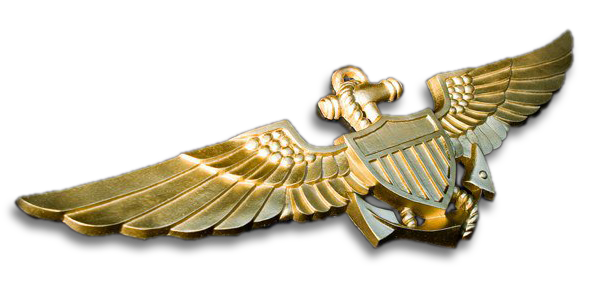 CDR Helmer was relieved by CDR W. A. Fitzgerald.
CDR Helmer was relieved by CDR W. A. Fitzgerald.
In February 2004, the Pelicans returned home from Sigonella completing a challenging six month Mediterranean deployment operating from eight different countries directly supporting the Global War on Terrorism. The squadron's most recent accolades include the Command Retention Excellence Award, a second consecutive CNO safety award and a second consecutive CPRW-11 nomination for Golden Wrench Award. To date, the squadron has logged more than 248,000 mishap-free flight hours. CDR Fitzgerald was relieved by CDR Richard T. Fite in April 2004.
In March 2005, CDR Richard T. Fite was relieved by CDR William A. Zirzow. In June 2005, the squadron completed its rigorous Inter Deployment Readiness Cycle. Fully qualified and eager to deploy, VP-45 set a new precedent as the first East coast VP squadron to deploy to Fifth and Seventh Fleets since the Vietnam Era. Operating out of sixteen countries throughout the deployment the Pelicans flew over 3800 hours in direct support of Operations IRAQI FREEDOM and ENDURING FREEDOM and were the first to establish a detachment in Iraq while capturing the battle space in real time for the troops on the ground and for theatre Commanders. Additionally, VP-45 established a new Maritime Patrol Reconnaissance hub at Al Udied Air Base, Qatar. For their outstanding performance the Pelicans were awarded the 2005 Battle "E" and Arliegh Burke Award.
In May 2006 CDR William A. Zirzow was relieved by CDR Mark L. Turner. As Commanding Officer, he oversaw squadron combat operations throughout FIFTH and SEVENTH Fleet in support of Operations IRAQI FREEDOM and ENDURING FREEDOM. During this tour he led the MPRF transition to the Warfare Development and Consolidated Maintenance constructs. CDR Thomas L. Thompson relieved CDR Zirzow in May 2007.
From January 2008 until May 2009 the Pelicans completed a highly demanding Inter-Deployment Readiness Cycle while surging combat aircrews to EUCOM, SOUTHCOM, CENTCOM, and PACOM Theaters supporting ongoing efforts in the Global War on Terrorism. Additionally, VP-45 actively participated in Defense Support to Civil Agencies following Hurricanes Ike and Gustav and played significant roles in Homeland Defense Operations including the Presidential Inauguration. During this IDRC period, the Pelicans accomplished a major milestone when they surpassed an unprecedented 40 years and 247,000 mishap-free flight hours. In April of 2008, CDR Thomas Thompson turned over command of VP-45 to CDR Gordon ‘Gordo’ Wilson, and in May of 2009 CDR Wilson turned over to CDR Andrew Smith.
From June to December 2009, the squadron completed a dual site deployment to Kadena, Japan and Comalapa, El Salvador in support of SEVENTH and FOURTH Fleets including Operations CARIB SHIELD and CAPER FOCUS and United Nations Security Council resolution 1874, enforcement of non-proliferations against North Korea. During the deployment, the Pelicans flew 628 sorties totaling more than 3550 mishap-free flight hours. Upon their return to NAS Jacksonville, the Pelicans commenced an 18 month IDRC in which they were recognized with two Safety “S” Awards and the 2010 Battle “E” Award. VP-45 also won the CPRG Fleet ASW Challenge and CPRW-11 ASW Rodeo while participating in the Centennial of Naval Aviation celebration. Additionally, during the first few months of their IDRC, the Pelicans flew 16 sorties for more than 149 hours in support of Operation UNIFIED RESPONSE which provided aid to the victims of the devastating earthquake in Haiti. In May of 2010 CDR Smith turned over command of VP-45 to CDR Mike ‘Dough’ Doherty.
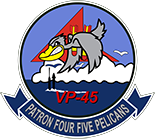 In May 2011 CDR Paul “P-Ditty” Ditch assumed command and VP-45 welcomed CDR Mike “Dick” Vitali as Executive Officer. Later that month, the Pelicans began another tri-site deployment to Sigonella, El Salvador, and Djibouti. During the six month deployment, the Pelicans participated in a wide variety of missions to include counter-drug operations, Naval Gunfire Support, surveillance and Strike Coordination and Reporting in support of Operation UNIFIED PROTECTOR, and counter-piracy operations in the Horn of Africa. The squadron also participated in Operations CAPER FOCUS and CARIB SHIELD while deployed to El Salvador. While conducting these operations the Pelicans also participated in numerous joint and multi-
In May 2011 CDR Paul “P-Ditty” Ditch assumed command and VP-45 welcomed CDR Mike “Dick” Vitali as Executive Officer. Later that month, the Pelicans began another tri-site deployment to Sigonella, El Salvador, and Djibouti. During the six month deployment, the Pelicans participated in a wide variety of missions to include counter-drug operations, Naval Gunfire Support, surveillance and Strike Coordination and Reporting in support of Operation UNIFIED PROTECTOR, and counter-piracy operations in the Horn of Africa. The squadron also participated in Operations CAPER FOCUS and CARIB SHIELD while deployed to El Salvador. While conducting these operations the Pelicans also participated in numerous joint and multi- national exercises including Phoenix Express in Italy, SEA BREEZE in Ukraine, BREEZE in Bulgaria, JUNCTION RAIN and AMLEP (African Maritime Law Enforcement Partnership) in Senegal, RELIANT MERMIAD in Crete, NORTHERN COAST in Germany, JOINT WARRIOR in Scotland, TEAM WORK SOUTH in Chile, and GRAMPUS in France and Portugal. In addition, the Pelicans particpated in the Malta International Airshow, and MAKS Airshow in Moscow, Russia. This second appearance made history as it was the first time a P-3C Orion had ever been inside Russian borders. Throughout the deployment, the Pelicans flew 568 sorties and logged 5,708 mishap-free flight hours.
national exercises including Phoenix Express in Italy, SEA BREEZE in Ukraine, BREEZE in Bulgaria, JUNCTION RAIN and AMLEP (African Maritime Law Enforcement Partnership) in Senegal, RELIANT MERMIAD in Crete, NORTHERN COAST in Germany, JOINT WARRIOR in Scotland, TEAM WORK SOUTH in Chile, and GRAMPUS in France and Portugal. In addition, the Pelicans particpated in the Malta International Airshow, and MAKS Airshow in Moscow, Russia. This second appearance made history as it was the first time a P-3C Orion had ever been inside Russian borders. Throughout the deployment, the Pelicans flew 568 sorties and logged 5,708 mishap-free flight hours.
Send questions, comments or suggestions regarding this website to: vp45association.org
Copyright © 2019 PATRON FOUR FIVE ASSOCIATION